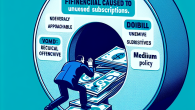From App Addict to Money Tracker: My Fintech Dashboard Obsession
What Is a Budget (And Why You Definitely Need One)
Hey there, future finance champ! It’s Tom Bradley here—your friendly neighborhood money mentor—and today I’m tackling a word that either makes people yawn or panic: budget.
I promise you, it’s not as terrifying as it sounds. In fact, if you can use TikTok for 15 minutes straight (more like two hours, if we’re honest), then you’ve got all the brainpower you need to put together a budget. Let’s dive into what a budget really is, why you absolutely need one, and how you can start creating yours today—even if you hate spreadsheets. Don’t worry, I’ve got you.
What Is a Budget, Really?
Let’s cut through the fluff. A budget is simply a plan for your money. That’s it. It’s a way to tell your dollars where to go instead of wondering where they went when your card gets declined at Starbucks (again).
Think of it as your personal GPS. Without one, you’re just driving around hoping you get somewhere. With a budget, you’ve got directions—and maybe even a few shortcuts.
Here’s what a budget helps you track:
- How much money is coming in (your income)
- How much money is going out (your expenses)
- What’s left over (or not!)
So, if your paycheck feels like it disappears faster than your Wi-Fi when you need it most, a budget will help you get control of the situation. Still with me? Great.
Why You Definitely Need a Budget
Whether you’re bringing in $500 or $5,000 a month, a budget is non-negotiable. I know it doesn’t sound sexy, but neither does bankruptcy—and one of these can help you avoid the other (I’ll let you guess which).
Here are 5 reasons budgeting is a total game-changer:
- Prevents overspending: You’ll stop those “how did I blow $300 on food delivery?” moments.
- Gives you control: Instead of reacting to bills, you’ll plan for them.
- Reduces stress: Less surprise = less anxiety = better sleep = healthier skin = you’re welcome.
- Helps crush debt: You’ll finally see where you can free up cash to pay off that credit card.
- Lets you save for stuff that actually matters: Like travel, a new laptop, or your dream car (or, let’s be real, just having rent covered feels dreamy enough).
Types of Budgeting Methods (Choose Your Fighter)
Not every budget looks the same, and that’s okay. We’ve all got different money vibes. Let me break down a few popular methods so you can pick what fits your lifestyle best.
1. The 50/30/20 Rule
This one’s a classic for a reason.
- 50% Needs: Rent, bills, groceries—adulting stuff.
- 30% Wants: Netflix, takeout, taco Tuesdays.
- 20% Savings/Debt: Emergency fund, debt repayments, or investing for your future rich self.
It’s simple, clear, and beginner-friendly. If you hate math (no shame), start here.
2. Zero-Based Budgeting
With this method, every dollar gets a job—nothing just hangs out. At the end of the month, your income minus expenses equals zero. That doesn’t mean you’re broke—it means you’ve accounted for everything.
It looks like this:
- Income: $2,000
- Rent: $800
- Groceries: $200
- Transportation: $150
- Fun Money: $100
- Savings/Debt: $750
- Total = $2,000
Cool, right? It’s like Sudoku but with money.
3. The Envelope Method (With a Modern Twist)
Old-school cool. You literally divide your money into envelopes based on categories. In the digital world, many apps mimic this style—no envelopes needed, no paper cuts.
When the “eating out” envelope runs out, no more sushi until next month. Sad, but strong.
Step-by-Step: Building Your First Budget
Ready to make one? I’ll guide you like a GPS with chill vibes.
Step 1: Know Your Income
Write down every dollar you bring in each month—your salary, side hustle, dog walking gig, whatever. Keep it real. Gross income (before taxes) looks prettier, but we work with net income (after taxes).
Step 2: List Your Expenses
Start with must-haves (rent, groceries) and move to nice-to-haves (coffee runs, subscriptions).
- Fixed expenses: Same every month (Netflix, rent)
- Variable expenses: Fluctuate (gas, food, shopping)
Step 3: Subtract Expenses from Income
What’s left? Great. Use it to build savings or pay off debt. If you’re in the negative, no shame—just time to tweak.
Step 4: Make Adjustments
If fun expenses are draining you, dial them back. It’s like removing junk from your phone to make space—except here you make space for financial goals.
Step 5: Track and Review
This isn’t a “set it and forget it” deal. Check in weekly. Budgets are living things—like plants. Ignore it and it dies. Water it (review it) and it grows.
Tips to Stick to Your Budget Without Losing Your Mind
I get it. Budgets sound restrictive. But they’re not handcuffs—they’re a seatbelt. Let’s keep you from flying through the windshield of debt.
- Use apps: Tools like Mint, YNAB, or Goodbudget make things visual and fun-ish.
- Reward yourself: Hit your goals? Treat yourself (within budget, of course).
- Be flexible: Life happens. Don’t beat yourself up over one bad day or even one bad month.
- Make it personal: Your budget doesn’t have to look like anyone else’s. This is YOUR journey.
The Bottom Line (Because We Like Money Lines)
A budget won’t solve all your problems overnight, but it gives you the power to stop guessing and start deciding where your money goes.
It’s not about perfection—it’s about progress. Start messy, stay consistent, and celebrate the small wins (like figuring out what a budget even is—nice job, by the way!).
Remember: budgeting isn’t punishment—it’s freedom in disguise. You’ve got this, and I’ll be here cheering you on with my calculator in one hand and coffee in the other.
Want help creating your first budget or have a question? Reach out to us here, or swing by our about page to learn more about who we are and the financial mission we’re on together.









Leave a Reply